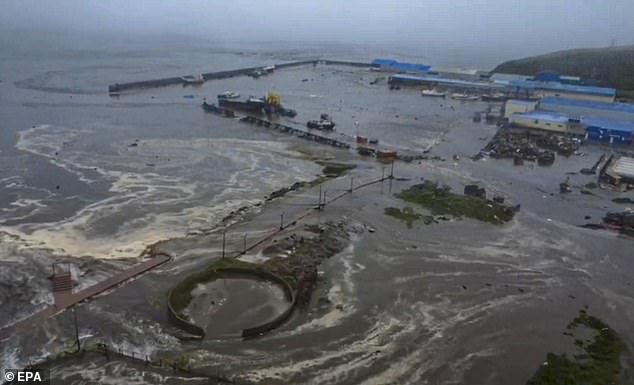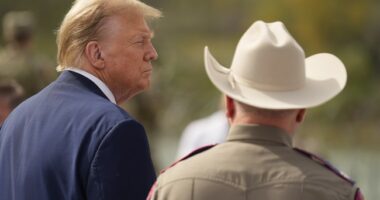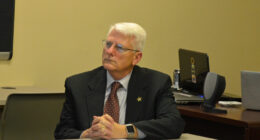A colossal 8.8-magnitude earthquake rocked Russia’s far eastern Kamchatka Peninsula early yesterday morning – raising serious questions about the condition of Russia’s key nuclear submarine bases, located alarmingly close to the epicentre.
The quake, tied for the sixth strongest in recorded history, struck just 75 miles from Avacha Bay, where some of the Russian Navy’s most strategic nuclear assets, including Borei and Delta-class ballistic missile submarines, are based.
Though Russian authorities are insisting the situation is under control, with ‘no reported fatalities or serious injuries’, military analysts and international observers are sounding the alarm over the potential impact on these high-security naval installations.
‘I have no information that critical damage to the Russian Navy’s naval bases in Kamchatka. I think everything is within the normal range,’ said a retired Russian Navy officer who goes by @Capt_Navy on X, adding: ‘These bases were designed and built with the possibility of a nuclear attack by the enemy in mind.’

The Foreign Office has issued an urgent warning to holidaymakers heading to 15 major tourist hotspots following a huge 8.8 magnitude earthquake that struck off the coast of Russia on Tuesday

It raised serious questions about the condition of Russia’s key nuclear submarine bases, located alarmingly close to the epicentre

Australia was added to tsunami warning list, along with 15 nations across the globe
The Rybachiy submarine base, located within Avacha Bay, is home to the majority of Russia’s modern Borei and Borei-A class nuclear ballistic missile submarines – the backbone of Moscow’s strategic deterrent.
The older Delta III-class Ryazan (K-44) also remains at the base, although its current status is unclear.
While no definitive reports of damage have emerged, online footage shows extensive destruction to civilian infrastructure throughout Kamchatka, including collapsed buildings, damaged ports, and buckled roads.
In Petropavlovsk-Kamchatskiy, the peninsula’s capital and another vital naval hub, a kindergarten collapsed, and several people were injured, according to Russian officials.
‘Unfortunately, there are some people injured during the seismic event,’ said Oleg Melnikov, the regional health minister.
‘Some were hurt while running outside, and one patient jumped out of a window. A woman was also injured inside the new airport terminal.’
The Klyuchevskaya Sopka volcano, one of the most active in the region, has also erupted in the aftermath, compounding fears of further disruption and highlighting the fragility of this volatile corner of the Pacific Ring of Fire.
Tsunami warnings were issued across a dozen countries, including Japan, Chile, Peru, and the United States, with waves over 5 feet reported in Hawaii.

Rescuers in Russia are pictured inspecting a kindergarten damaged by a massive earthquake on Tuesday
The UK Foreign Office issued travel warnings for British nationals visiting affected areas.
Military analysts are now poring over limited satellite imagery and conflicting reports in an effort to determine what submarines were present in Avacha Bay at the time of the quake. However, overcast conditions in the region have made analysis difficult.
Besides the nuclear-armed Borei fleet, the base is home to Yasen-M and Oscar-class guided missile submarines (SSGNs), among the most advanced in the Russian Navy’s arsenal.
These conventionally armed vessels pose a significant threat, and their status post-quake is still unknown.
There are also reports that Russia’s mysterious K-329 Belgorod, the longest submarine in the world, may soon be based in Avacha Bay. The submarine, which can carry nuclear-powered Poseidon torpedoes, is also capable of undersea espionage missions.
While the geography of Avacha Bay may have helped shield moored vessels from the worst of the tsunami, even relatively minor surges could be damaging.
Experts warn that submarines striking their moorings or flooding via open hatches could cause serious operational issues — especially if vessels were undergoing maintenance.
The earthquake struck at 7:24pm EST, around 84 miles east-southeast of Kamchatka, and was the strongest globally since Japan’s 9.1 megaquake in 2011, which left nearly 20,000 people dead or missing. Today’s seismic shock has sent ripples of fear across the Pacific.
Japan has ordered nearly two million residents to evacuate coastal areas, while U.S. officials have issued tsunami warnings from California to Oregon. In Hawaii, waves exceeding 5 feet battered Oahu’s north shore within minutes of impact.
Tourists across the Pacific are being urged to stay vigilant. The UK Foreign Office warned British citizens in the region:
‘If you are in the affected areas potentially affected by the earthquake or tsunami you should follow the advice of the local authorities.’
Though the immediate tsunami threat has now been declared over by Russian authorities, they warn aftershocks may still pose danger.









